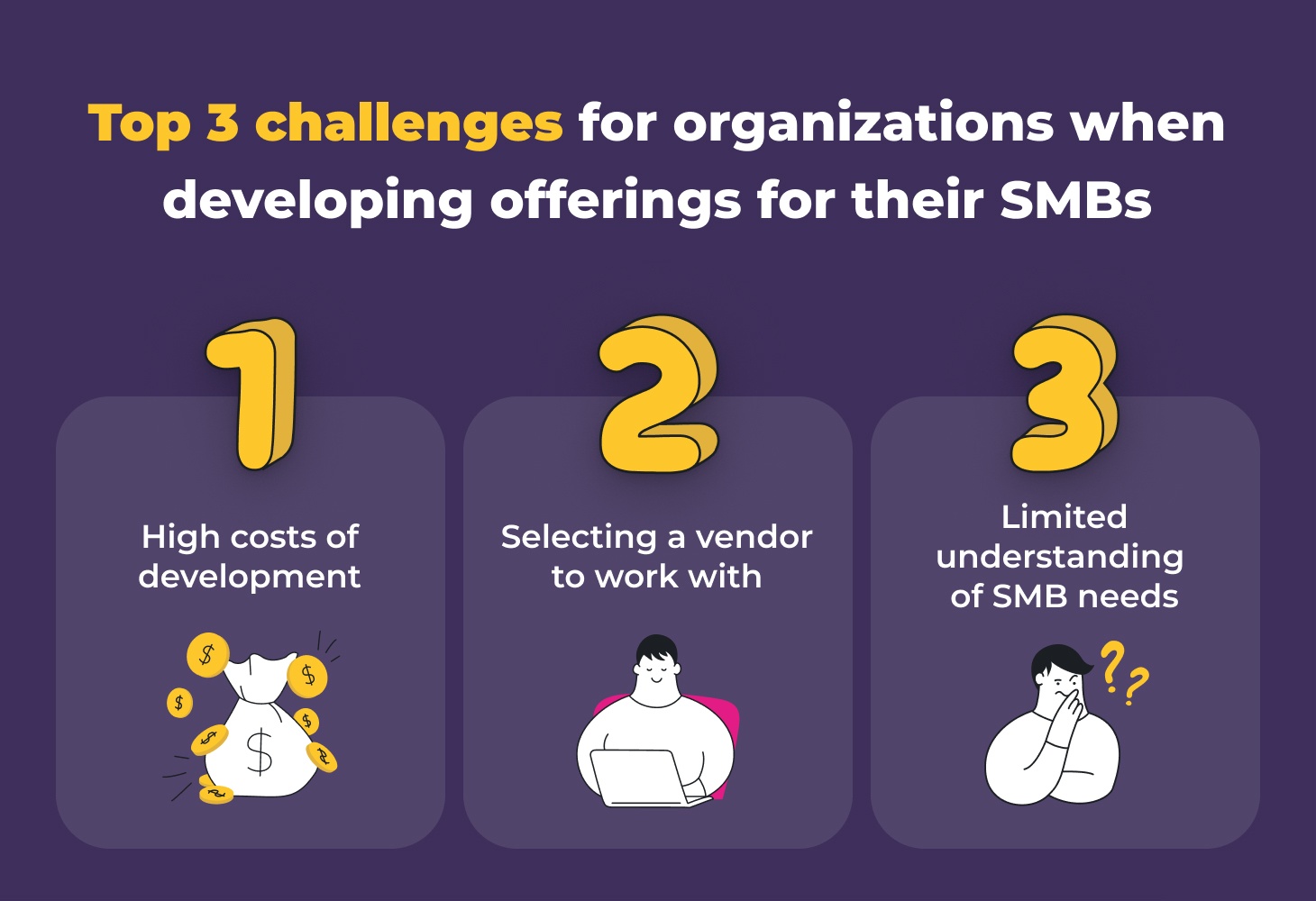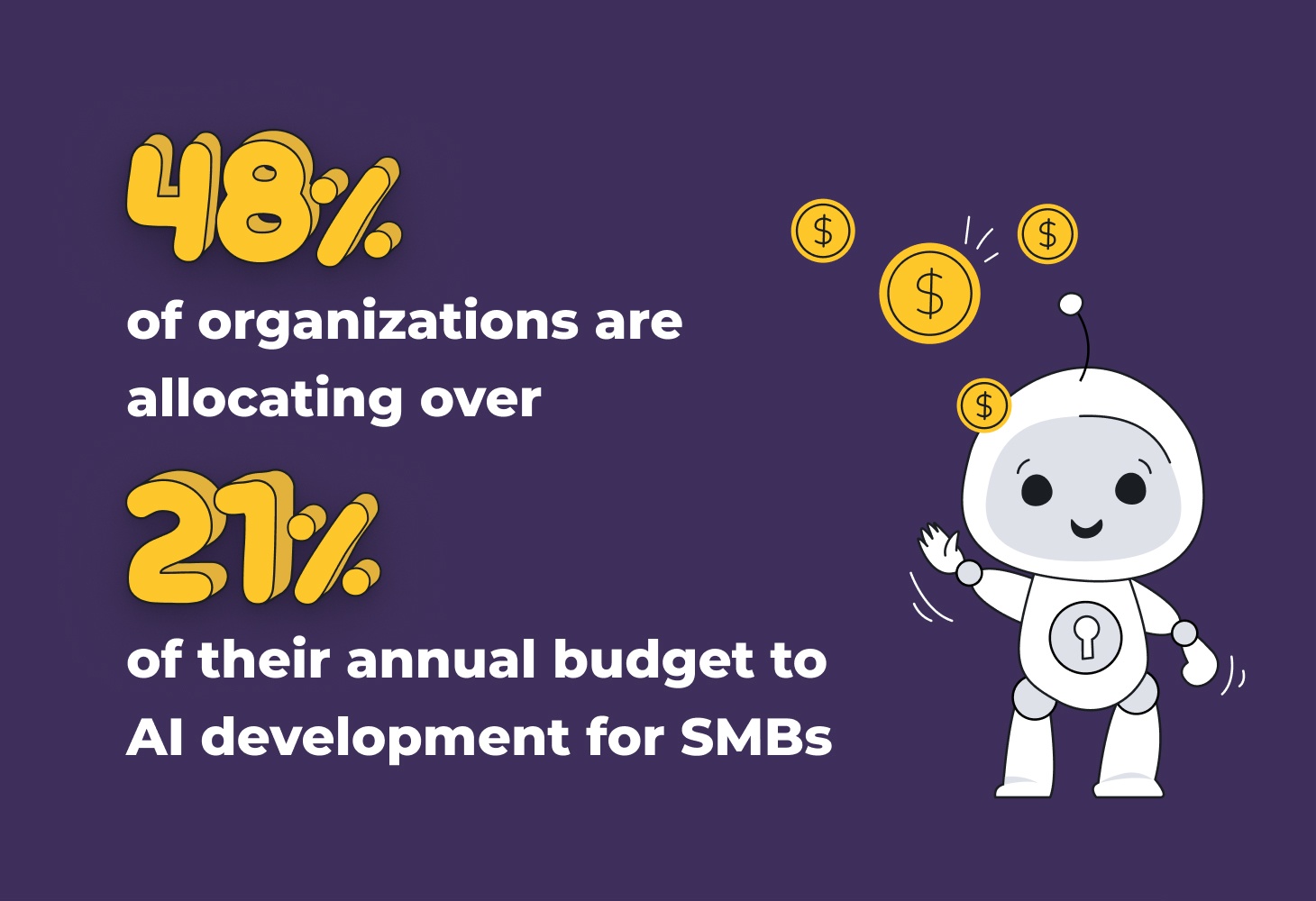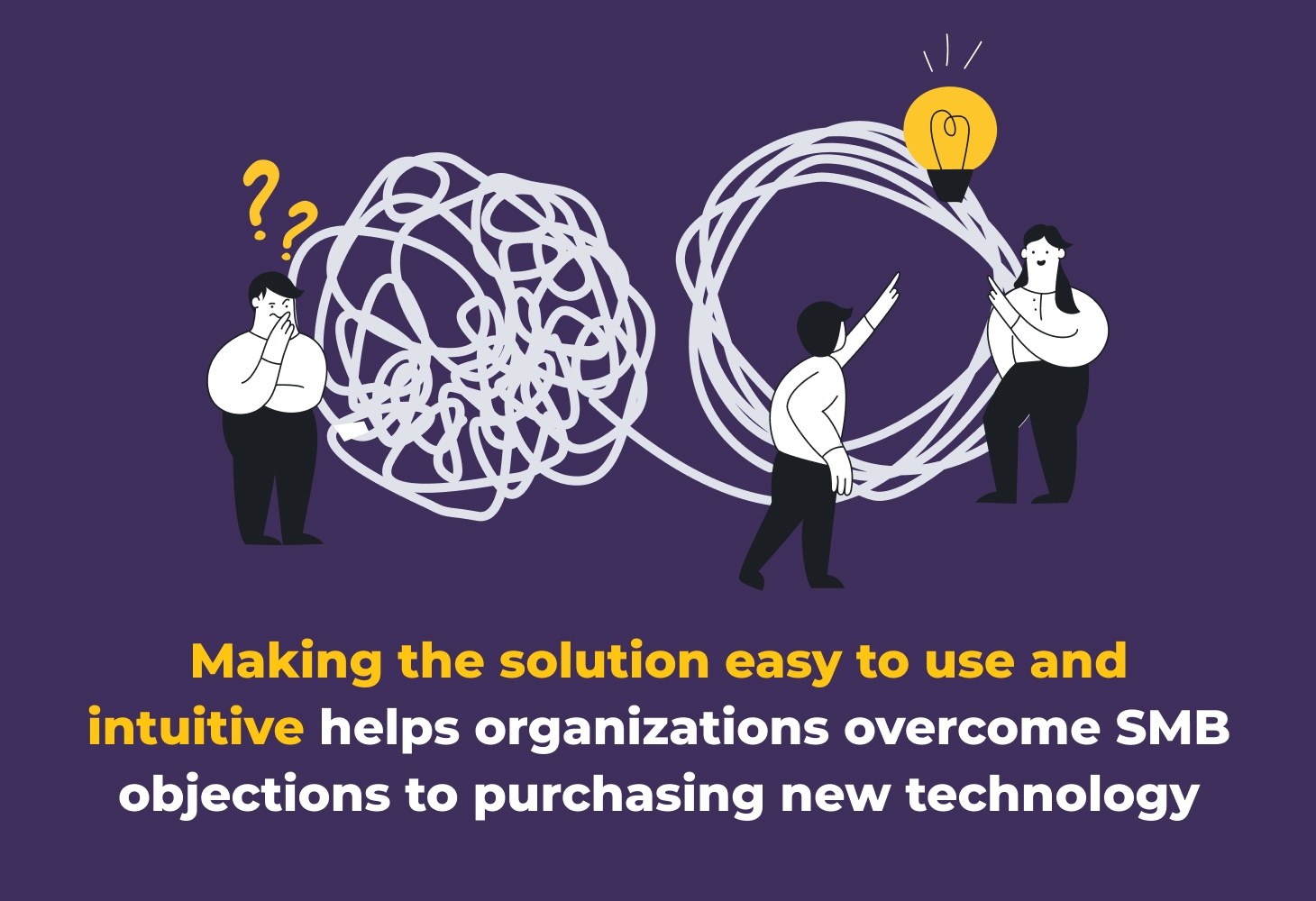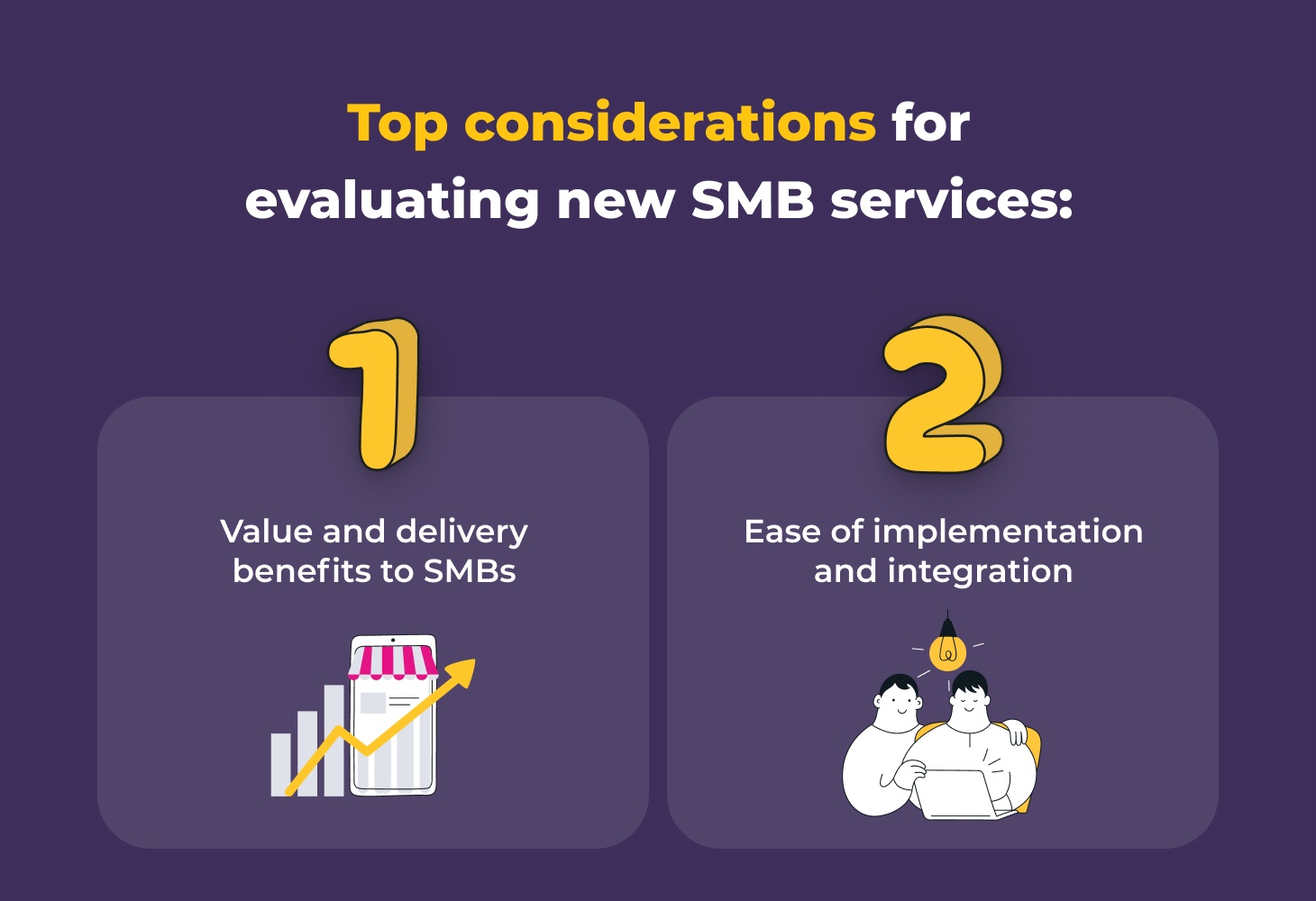SMB-serving enterprises are struggling to retain their SMB clients, and churn has become a major issue. According to our 2023 marketing survey report, 70% of SMBs outsource their marketing– yet 67% churned within six months or less. The primary reasons for this were a lack of visible ROI and the feeling that the service provider wasn’t acting as a true partner.
Our most recent telco survey revealed even more concerning figures, with churn rates for core telco services ranging between 8-12%, and an astonishing 97% churn reported across all services. The top reasons included pricing issues, unsatisfactory service levels, and customers finding more relevant packages elsewhere.
Given that SMBs make up a substantial portion of the workforce, organizations cannot afford to overlook this segment. Yet, serving this market comes with a unique set of challenges. SMBs require a delicate touch and a highly strategic approach, particularly when exploring verticalization. To stay competitive, SMB-serving companies must differentiate themselves and consistently expand their offerings, adding genuine value to their SMB clients.
To gain a comprehensive understanding of how organizations serving SMBs are navigating this landscape, we conducted a survey of telcos and marketing agencies/digital marketing companies across the U.S.
Survey methodology
The survey included 100 participants in senior leadership roles such as Directors, VPs, and C-level executives, including positions in Business Development, Innovation, Growth, Sales, and the C-suite (CRO, CEO). Each participant represented an organization with at least 1,000 SMB clients.
Our survey focused on several key areas:
- The considerations companies have when adding new services for SMBs
- Their plans for implementing AI tools tailored to SMBs
- How these organizations encourage the adoption of their SMB solutions
Through this survey, we gathered insights on the challenges and strategies SMB-serving organizations face. This blog provides a brief overview of the most significant findings, offering a snapshot of the trends and approaches companies are taking to better serve their SMB clients.
Challenges in developing SMB offerings

Organizations serving SMBs face a range of challenges when developing new offerings for this market. According to our survey, the most significant challenge is the high cost of development (40%), followed by difficulties in selecting the right vendor (37%) and a limited understanding of SMB needs (35%).
For companies that develop SMB services in-house, the costs go beyond the initial creation. Ongoing maintenance, updates, and upgrades are necessary to keep these technologies relevant, further increasing the overall expense. Finding the right partner is also critical but can be difficult. Selecting a vendor requires a great deal of trust, and identifying one that is both reliable and experienced can be a challenging task.
Furthermore, companies that don’t exclusively focus on SMBs often struggle to keep up with the diverse and evolving needs of this segment. Unlike enterprise customers, SMBs require more personalized and dynamic solutions. A one-size-fits-all approach simply doesn’t work in this market. Partnering with a knowledgeable company specializing in SMB services can help bridge these gaps. By integrating services into a white-labeled platform and leveraging a partner’s expertise, organizations can better meet the specific needs of their SMB clients and reduce development costs.
Another key challenge lies in a lack of internal expertise regarding SMBs. Our survey found that 44% of senior leaders, including Directors, VPs, and C-level executives, believe there are gaps in their internal processes and resources for understanding and managing SMB needs. This underscores the importance of building internal frameworks designed to stay in sync with the constantly evolving SMB landscape, which could unlock greater opportunities for growth.
Beyond understanding SMBs, many organizations also identified sales and support as a critical barrier to successful market implementation, with 28% of respondents naming it their top challenge. This can often be a direct result of a limited understanding of SMB needs and insufficient internal processes.
Partnering with companies that have extensive experience in serving SMBs and offer fully managed programs can be a highly effective way to overcome these challenges. The right partnership can provide the tools, support, and knowledge necessary to help companies quickly get their solutions off the ground and ensure long-term success in the SMB market.
Expanding focus on AI and new trends
Despite the challenges of serving SMBs, organizations are actively expanding their offerings and focusing on value-added SaaS offerings, particularly in artificial intelligence-based software. According to our survey, every organization we spoke with is currently developing AI solutions specifically for SMBs, recognizing that AI can provide substantial value and a competitive edge. They understand that AI has the potential to revolutionize how SMBs operate, offering efficiencies and new capabilities that were previously out of reach for smaller businesses.

A significant portion of the companies surveyed are making substantial financial investments in AI development. The majority of respondents (46%) are spending between $250k and $500k annually on AI initiatives for SMBs, with 48% of organizations allocating more than the average 21% of their budget toward AI development. This level of investment highlights the importance these companies place on staying competitive and helping SMBs adapt to new technological trends.
While a report from the Small Business Digital Alliance shows that only 13% of SMBs are currently very familiar with AI tools, AI adoption is expected to grow significantly. Our survey forecasts that AI adoption will increase by 25% or more in the next five years compared to 2023 levels. Organizations are preparing for this shift, with the majority expecting up to 30% of their revenue to come from AI tools marketed to their SMB clients by 2025/2026.
These findings demonstrate that organizations recognize the value AI can bring to SMBs and are willing to invest heavily in its development, even with the expectation that the ROI over the next five years may decrease. The focus on AI reflects a commitment to remain competitive and provide SMBs with the tools they need to thrive in a rapidly evolving landscape.
Overcoming obstacles to purchase and adoption

Organizations are increasingly focusing on education and ease of use as key strategies to overcoming SMB objections when purchasing new technologies. When asked about the most successful approaches to this issue, respondents highlighted four key strategies:
- Making solutions easy to use and intuitive (25%): SMBs value quick and easy implementations, as they are often time-starved and lack the resources to dedicate to complex or time-consuming tools. They prioritize solutions that are user-friendly and can be integrated into day-to-day operations with minimal effort.
- Robust customer onboarding and support (22%): SMBs still need support when adopting new tools, and organizations that offer comprehensive onboarding and ongoing assistance have a clear advantage. Companies that provide the necessary support through the implementation process are more likely to see higher conversion rates and better client retention than those that leave SMBs to navigate the tools independently.
- Regular updates and feature enhancements (20%): SMBs have diverse and evolving needs, and they look for solutions that can grow and adapt alongside their businesses. Organizations that stay proactive with regular product updates and improvements are better positioned to retain their SMB clients by continuously offering relevant solutions.
- Bundling multiple services into a single package (18%): SMBs prefer the convenience of getting all their tools from one provider and it’s in these organizations’ best interest to supply the demand. For example, a marketing company that provides services specializing in improving the SMBs’ presence and lead capture could benefit from offering a CRM, payments, and other tools included in a business management platform as an all-in-one solution. Telcos, on the other hand, can expand beyond basic connectivity services and offer tools that SMBs need to run their business, integrated with their existing services to create a bundled package that SMBs will love. This integrated approach not only improves customer satisfaction but also boosts loyalty and retention by making it easier for SMBs to manage their operations from a single platform.
When it comes to encouraging the adoption of new technologies, our survey indicated that organizations are doing everything possible to maximize the effectiveness of their solutions. The top three approaches included:
- Adding contextual in-product education (25%): SMBs appreciate having real-time guidance within the product itself. This reduces friction during the learning process and empowers SMBs to use the tools effectively without requiring extensive external training.
- Providing detailed product demonstrations (16%): SMBs respond positively to detailed demonstrations that walk them through how the solution will meet their specific needs. This builds trust and confidence in the product’s value.
- Customizing solutions to meet specific needs (16%): By understanding the exact needs of an SMB, organizations can adapt their offerings more quickly and effectively. This flexibility allows companies to address unique challenges in the SMB space, helping them capture and retain more of the market.
Organizations’ #1 priority: Value to SMBs

While there is often a lack of internal expertise in fully understanding the needs of SMBs, it is evident that companies are eager to tap into this segment. Despite the challenges, upper-level management recognizes that supporting SMBs with solutions that are both effective and easy to adopt is essential.
Our survey respondents confirmed this sentiment when asked about top considerations for evaluating new services to add to their profiles for SMBs. The two most important factors identified were:
- Value delivery and benefits to SMBs (31%): SMBs need solutions that make a noticeable difference in their operations. Whether it’s improving workflows, reducing costs, or enhancing customer satisfaction, organizations must ensure that their offerings provide real, actionable value. Without this, they risk low adoption rates and high churn.
- Ease of implementation and integration (31%): SMBs are often resource-constrained and time-starved, so solutions must be easy to implement and integrate into their existing systems. Burdening SMBs with complex or cumbersome technologies could lead to frustration, hindering adoption and potentially driving clients away.
SMB-serving organizations are learning to crack the code
The organizations we surveyed are actively working to crack the code when it comes to serving SMBs. While they face ongoing challenges—such as the high costs of development, selecting reliable vendors, and understanding the ever-changing needs of SMBs—they are finding effective ways to address these obstacles.
By investing in AI technologies, organizations are giving SMBs the tools they need to innovate and streamline their operations. They are prioritizing their products’ value, ensuring that their offerings make a tangible difference in the day-to-day functioning of SMBs. And they’re focusing on education and ease-of-use, recognizing that SMBs need intuitive solutions, paired with robust customer support and onboarding.
However, one of the most valuable strategies for overcoming these challenges may lie in partnering with SMB technology experts. By working with experienced partners, organizations can reduce development costs, accelerate time-to-market, and bring critical SMB solutions to their clients faster. These partnerships can bridge knowledge gaps, reduce risks, and ensure that companies remain competitive in the SMB space.
SMBs can be a tough market to serve, with their fluctuating budgets and limited resources. For organizations looking to succeed, gaining deeper insights into the specific needs of SMBs and refining their strategies to better meet those needs will be key. By understanding what drives SMBs and delivering the right solutions, organizations can foster long-term loyalty with this vital segment.
To read the full report, packed with all the survey results and their insights, click here.



























